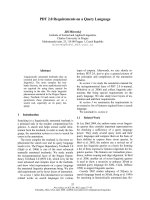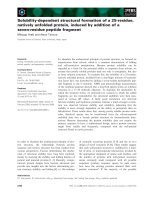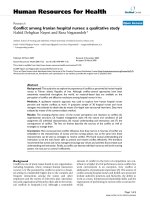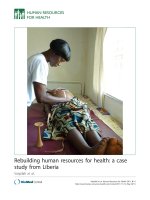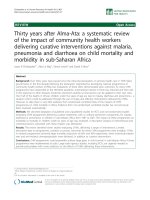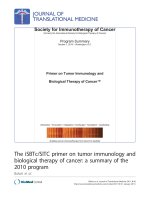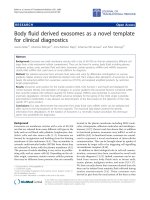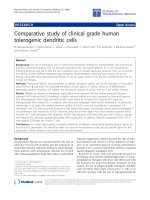Báo cáo sinh học: " RNAi dependent epigenetic marks on a geminivirus promoter" pptx
Bạn đang xem bản rút gọn của tài liệu. Xem và tải ngay bản đầy đủ của tài liệu tại đây (602.91 KB, 4 trang )
BioMed Central
Page 1 of 4
(page number not for citation purposes)
Virology Journal
Open Access
Short report
RNAi dependent epigenetic marks on a geminivirus promoter
Afzal Muhammad Dogar*
Address: Swiss Institute for Experimental Cancer Research (ISREC), Ch. des Boveresses 155, CH-1066 Epalinges, Switzerland
Email: Afzal Muhammad Dogar* -
* Corresponding author
Abstract
Nicotiana benthamiana plants were stably transformed with an intron-spliced dsRNA producing
construct cognate to bidirectional promoter of African cassava mosaic geminivirus (ACMV) DNA
A. Transgenic lines expressed multiple siRNAs species upon ACMV infection. The de novo DNA
methylation and an increased proportion of histone H3 Lysine-9 methylation (H3K9) at intergenic
region (IGR) of ACMV DNA A were observed.
Introduction
In plants RNA interference or post transcriptional gene
silencing (PTGS) acts as a natural anti-viral defense system
for neutralizing pathogenic nucleic acids either through a
change in RNA stability in the cytoplasm or through
mechanisms that use the RNA itself to induce methylation
and silencing of homologous nuclear genes [1]. In addi-
tion there are more than one Dicer and Argonaute pro-
teins in plants e.g. Arabidopsis genome encodes four
Dicers [2] and ten Argonate orthologs [3]. Geminiviruses
are single-stranded circular DNA viruses that cause eco-
nomically significant diseases in a wide range of crop
plants worldwide [4]. They replicate in the plant cell
nuclei through transcription and replication competent
double stranded DNA intermediate, which is packed into
nucleosomes from host cells [5]. In plants, some gemini-
virus-host interactions naturally lead to host recovery e.g.
natural recovery response induced by ACMV-infected N.
benthamiana and cassava involves siRNAs originating
from geminivirus genome [6]. However the affect of siR-
NAs at the virus genome remained to be seen. Here I show
multiple siRNAs species in transgenic plants direct the
methylation of ACMV DNA A as well as the methylation
at lysine-9 residues of histone H3 wrapping the promoter
region in the virus genome.
The study
A 360 nucleotides fragment corresponding to the inter-
genic region of ACMV DNA A (GenBank: NC_001467
)
was cloned in sense and anti-sense orientation inter-
rupted with a synthetic plant intron. The left arm KpnI-
ClaI and right arm XhoI-BamI fragments were PCR
amplifed and cloned into dsproA VMYMV- int vector [7].
The EcoRI-XbaI fragment of this vector was cloned into
pCambia 1300. The following primers used for amplifica-
tion the left arm (KpnI F: GGTACCAATCTCAACTAGA-
GACACTCTTGA) and (ClaI R:
ATCGATGCACAAATATTTAATTGCCAG), and the right
arm (XhoI F: CTCGACGCAGTTTATAAATTAACGGGTC)
and (BamHI R: GGATCCAATGAGTTGATCTCTGTGA-
GAACT). The resulting binary construct was introduced
into Agrobacterium tumefaciens LBA4404 by electropora-
tion with a Gene Pulser apparatus (Bio-Rad). Seeds of
wild type Nicotina benthamiana were grown on MS media
at 25 to 27°C under artificial light (150 µmol s-1 m-2) for
16 h per day. Transgenic shoots were selected on Hygro-
mycin at a concentration of 250 µg ml-1 and grown at 25
to 27°C under artificial light (150 µmol s-1 m-2) for 16 h
per day. Seeds of T1 lines were grown on MS and two
weeks old seedlings were infected with the infectious
clones of ACMV Kenyan strain DNA A and ACMV Cam-
Published: 30 January 2006
Virology Journal 2006, 3:5 doi:10.1186/1743-422X-3-5
Received: 21 June 2005
Accepted: 30 January 2006
This article is available from: />© 2006 Dogar; licensee BioMed Central Ltd.
This is an Open Access article distributed under the terms of the Creative Commons Attribution License ( />),
which permits unrestricted use, distribution, and reproduction in any medium, provided the original work is properly cited.
Virology Journal 2006, 3:5 />Page 2 of 4
(page number not for citation purposes)
eroon strain DNA B (GenBank: AF112353) using Bio Rad
particle delivery system as previously described [8]. The
siRNA isolation and analysis was performed as described
previously [2]. The DNA probe used for siRNA northern
hybridization (AGGGGCCAACCGTATAATATTACCC)
corresponds to the Nona-nucleotide sequence within
ACMV DNA A. Total DNA was extracted from different
plant lines. 10 to 15 µg of DNA samples were digested
overnight with Sau96 I. Resolved by electrophoresis on
0.8 to 1.0 % agarose gel and transfered overnight to a
Hybond-N membrane. Southern hybridization was car-
ried out with an ACMV DNA A promoter specific DNA
probe labeled with digoxigenin (DIG) (Boehringer Man-
nheim Biochemicals) as described by manufacturers. The
Chromatin immunoprecipitation (ChIP) was performed
as described previously [9]. Anti-dimethyl-histone H3
[Lys9] #07–212 and anti- dimethyl-histone H3 [Lys4]
#07–030 were purchased from Upstate Biotechnology.
Each of the immunoprecipitation was performed at least
three independent times. For each PCR reaction 2 µl of
each immunoprecipiate used to amplify of the viral DNA
and endogenous control. All PCR reactions were done in
25 µl volume, starting with 5 min at 96°C, followed by 30
cycles of 94°C (15 s), 57°C (30 s), and 72°C (5 min). The
PCR reactions were analysed by electrophoresis on a 2%
agarose gel. The primer pairs used were ACMV DNA A F:
CTCAACTAGAGACACTCTTGA and R: CACAAATATT-
TAATTGCCAG, Tnt-retroposon (GenBank: X13777
) F:
CATTGGTTCTAAAGGATGTGCGGC and R: GAAATCT-
CATCTTGTGCCGCGTTC.
Results and conclusion
A transgene consisting of the promoter region of ACMV
DNA A was designed to produce double stranded RNA
(Figure 1A). A similar construct was shown to reduce the
accumulation of Vigna mungo yellow mosaic geminivirus
(VMYMV) in transient transfection system [7]. The Nico-
tiana benthamiana plants were transformed by Agro-
bacteium-mediated gene transfer. Resulting transgenic
lines were infected with ACMV and tested for siRNA
expression. Non-infected transgenic plants showed two
classes of siRNAs, a less abundant 24–25 nt and more
abundant 21–22 nt size class. However ACMV-infected
transgenic lines showed small RNAs of approximate sizes,
Small RNA expression in ACMV-infected and non-infected transgenic and vector control plantsFigure 1
Small RNA expression in ACMV-infected and non-infected transgenic and vector control plants. (A) Schematic
diagram of the binary construct used for plant transformation. LB, left border. RB, right border (B, C) Northern hybridization
showing various siRNA size classes, two lower arrows indicate (known) approximate sizes and upper arrow indicate higher
molecular weight size.
Tr
a
n
s
1
Tr
a
n
s
2
ACMV infection
Loading control
-
21nt
24nt
(B)
Tr
a
n
s
1
(A)
35 S promoter
Poly(A)
ACMV (IGR)
ACMV (IGR)
intron
RB
(C)
Nona nucleotide
antisense probe
+
+
-
Nona nucleotide
antisense probe
Nona nucleotide
sense probe
Loading control
T
r
a
n
s1
Tr
a
n
s
1
Tr
a
n
s
2
Tr
a
n
s
2
Tr
a
n
s
1
-+
++ -
ACMV infection
LB
21nt
24nt
V
e
c
-c
o
n
t
V
e
c
-
c
o
n
t
V
e
c
-
c
o
n
t
Virology Journal 2006, 3:5 />Page 3 of 4
(page number not for citation purposes)
21–22, 24–25 nt and also higher molecular weight siRNA
size class, with equally higher expression intensities (Fig-
ure 1B–C).
I analyzed the molecular effects of these abundant small
RNAs on ACMV genome in transgenic and vector control
plants. The 21–22 nt siRNA class has been implicated in
virus RNA and transgene mRNA degradation, whereas the
longer size class 24–25 nt, in directing retroelement DNA
methylation [2]. To test the methylation status of episo-
mal DNA virus, the total genomic DNA from ACMV-
infected transgenic and vector control plants was digested
with methylation sensitive enzyme Sau 96I. Southern
hybridization was performed by using an ACMV DNA A
promoter sequence specific probe. Analysis showed that
at least three to four sites in the ACMV DNA A promoter
region were protected from digestion only in siRNA
expressing lines but not in vector control plant (Figure
2A–B). The sites protected by methylation flank the Nona-
nucleotide sequence (which is the origin of replication or
Small RNA-directed DNA and histone methylationFigure 2
Small RNA-directed DNA and histone methylation. (A) Schematic representation of Sau96 I restriction sites in ACMV
DNA A promoter region and expected sizes recognized by this probe (B) Southern hybridization showing fragments of ACMV
generated by Sau96 I, arrows indicate fragments generated in vector control and protected in siRNA producing plants (C)
ChIP duplex PCR analysis using ACMV DNA A promoter and Tnt-retroposon specific primers, sizes are indicated. K4, anti-
dimethylated histone H3 lysine 4. K9, anti-dimethylated histone H3 lysine 9. VC, vector control.
801 bp
156 bp
66,69 bp
20,28 bp
-+ -+-+-+-+-+-
(A)
digestion
D
N
A
A
+
B
D
N
A
B
D
N
A
A
Sau 96I sites
Probe + RNAi
target
Expected sizes
recognized by
probe:
801 bp
156 bp
66,69 bp
20,28 bp
ACMV
DNA A
360 bp ACMV Promoter
206 bp Tnt-retroposon
(C)
VC-infected Trans1-infected VC-non-infected
Anti-dimet
Anti-dimet Anti-dimet
input K4 K9 input K4 K9 input K4 K9
(B)
Tr
a
n
s
1
Tr
a
n
s
2
V
e
c
-
c
o
n
t
V
e
c
-
c
o
n
t
Publish with BioMed Central and every
scientist can read your work free of charge
"BioMed Central will be the most significant development for
disseminating the results of biomedical research in our lifetime."
Sir Paul Nurse, Cancer Research UK
Your research papers will be:
available free of charge to the entire biomedical community
peer reviewed and published immediately upon acceptance
cited in PubMed and archived on PubMed Central
yours — you keep the copyright
Submit your manuscript here:
/>BioMedcentral
Virology Journal 2006, 3:5 />Page 4 of 4
(page number not for citation purposes)
ori) in ACMV DNA A intergenic region as the same
sequence was used to probe siRNAs.
The 24–25 nt siRNAs class along with Argonaute-4 has also
been shown for retroelement silencing through histone
H3 lysine 9 (H3K9) methylation in Arabidopsis [10]. The
geminiviruses exist as minichromosomes in plant cells
[5]. The histone methylation patterns of ACMV minichro-
mosomes were determined by chromatin immunoprecip-
itation using anti-dimethyl histone H3 lysine 4 (H3K4)
and anti-dimethyl histone H3 lysine 9 (H3K9). The ChIP
PCR amplified an equal amount of ACMV DNA A pro-
moter region fragment in the H3K4 immunprecipiates
from both transgenic and vector control plants. However
the enrichment of the same fragment in the H3K9
immunprecipiate was lower from the vector control plant
compared to the small RNA producing transgenic plants
(Figure 2C).
The presence of three small RNA species in these trans-
genic plants upon ACMV infection raises the possibility
that RNAi might operate at three levels during DNA virus
infection i.e. the mRNAs transcribed from geminivirus
genome are subject to degradation by 21–22 nt small
RNAs [6]. The geminiviral genomic DNA seems to be sub-
ject of RNA dependent DNA methylation (RdDM) by 24–
25 nt small RNAs. However the observation showing an
additional higher molecular weight siRNA class in trans-
genic plants might be similar to those 28 nt siRNAs
observed in Tetrahymena [11]. And the fact that a micro-
coccal nuclease homologue also co-purifies with the RNAi
effector complexes [12], raises further question whether
the plants also possess small RNA directed DNA elimina-
tion mechanism in order to defend themselves from DNA
viruses.
Competing interests
The author(s) declares that they have no competing inter-
ests.
Authors' contributions
AMD carried out all experimental work and drafted the
manuscript.
Acknowledgements
I thank Dr. A. Si-Ammour, Dr. M. Tariq, and Dr. K. Richert-Pöggeler for
their help during experiments and M. Beleut for critically reading the man-
uscript. This study was supported by the Friedrich Miescher Institute for
Biomedical Research in Basel, Switzerland.
References
1. Waterhouse PM, Wang MB, Lough T: Gene silencing as an adap-
tive defence against viruses. Nature 2001, 411:834-842.
2. Hamilton A, Voinnet O, Chappell L, Baulcombe D: Two classes of
short interfering RNA in RNA silencing. Embo J 2002,
21:4671-4679.
3. Hunter C, Sun H, Poethig RS: The Arabidopsis heterochronic
gene ZIPPY is an ARGONAUTE family member. Curr Biol
2003, 13:1734-1739.
4. Vanitharani R, Chellappan P, Fauquet CM: Geminiviruses and RNA
silencing. Trends Plant Sci 2005, 10:144-151.
5. Pilartz M, Jeske H: Abutilon mosaic geminivirus double-
stranded DNA is packed into minichromosomes. Virology
1992, 189:800-802.
6. Chellappan P, Vanitharani R, Fauquet CM: Short interfering RNA
accumulation correlates with host recovery in DNA virus-
infected hosts, and gene silencing targets specific viral
sequences. J Virol 2004, 78:7465-7477.
7. Pooggin M, Shivaprasad PV, Veluthambi K, Hohn T: RNAi targeting
of DNA virus in plants. Nat Biotechnol 2003, 21:131-132.
8. Klahre U, Crete P, Leuenberger SA, Iglesias VA, Meins FJ: High
molecular weight RNAs and small interfering RNAs induce
systemic posttranscriptional gene silencing in plants. Proc
Natl Acad Sci U S A 2002, 99:11981-11986.
9. Gendrel AV, Lippman Z, Yordan C, Colot V, Martienssen RA:
Dependence of heterochromatic histone H3 methylation
patterns on the Arabidopsis gene DDM1. Science 2002,
297:1871-1873.
10. Zilberman D, Cao X, Jacobsen SE: ARGONAUTE4 control of
locus-specific siRNA accumulation and DNA and histone
methylation. Science 2003, 299:716-719.
11. Mochizuki K, Fine NA, Fujisawa T, Gorovsky MA: Analysis of a
piwi-related gene implicates small RNAs in genome rear-
rangement in tetrahymena. Cell 2002, 110:689-699.
12. Caudy AA, Ketting RF, Hammond SM, Denli AM, Bathoorn AM, Tops
BB, Silva JM, Myers MM, Hannon GJ, Plasterk RH: A micrococcal
nuclease homologue in RNAi effector complexes. Nature
2003, 425:411-414.
